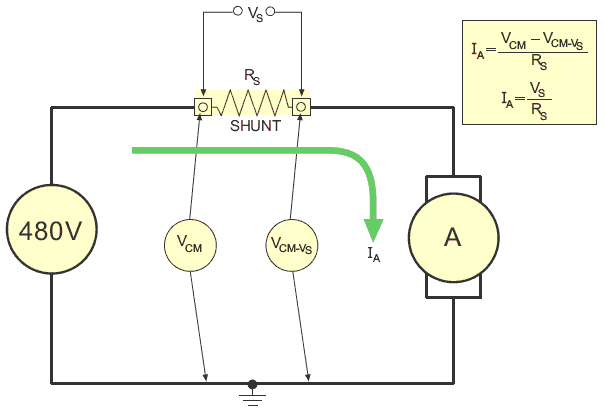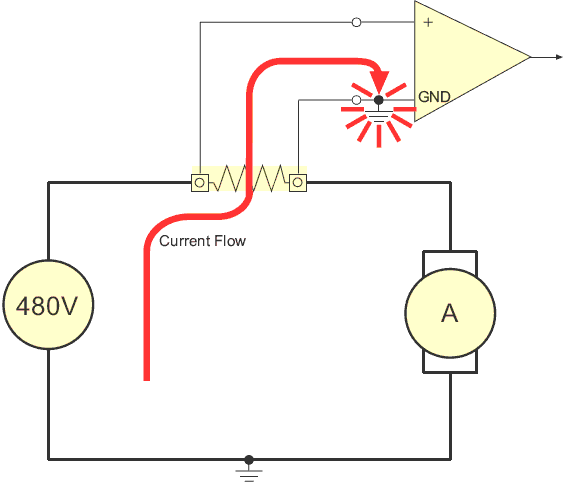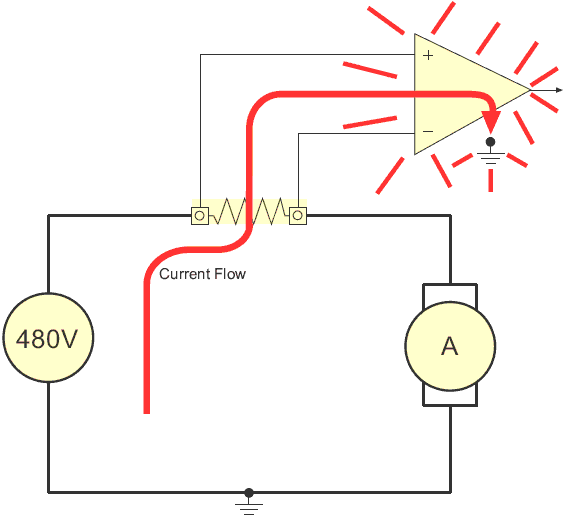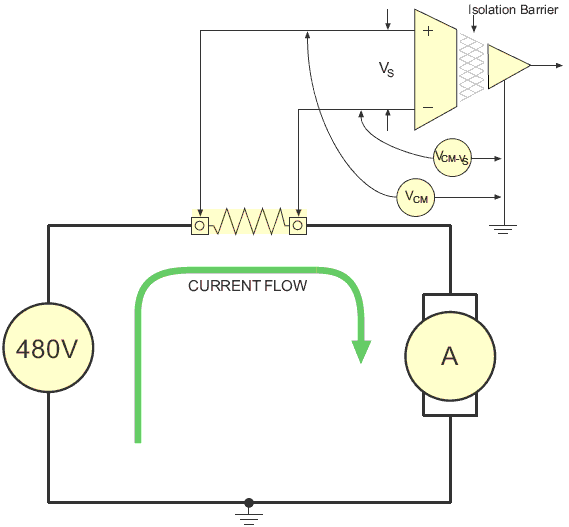The Importance of Isolation in Data Acquisition Applications
The concept of isolation when applied to instrumentation can be difficult to grasp for many who do not have formal instrumentation training or experience. Yet, an understanding of what it is, why it's important, and when you need it, is fundamental for safe and productive measurements in so many measurement applications. This paper examines these elements with a single goal: To equip its reader with a working foundation on which to build correct judgments of the importance of isolation in their own array of measurement situations.
To achieve this goal I will focus primarily on one extreme application, and then make a progression of measurements using different techniques (not unlike approaches I've actually seen made in the field). Some will lead to disaster. Others will work fine. For each, the reasons for success or failure will be fully described.
The Application
I have chosen a common industrial measurement to illustrate the importance of isolation. We'll measure the current delivered to the armature winding of a motor, which can be used to derive the torque it delivers while operating under a load. In most such applications, current is measured using a current shunt. This device acts as a resistor that provides a precisely calibrated, constant, and known resistance. When inserted in series with the armature power supply, the voltage developed across the shunt is directly proportional to the current delivered to the armature. Ohm's Law precisely defines this relationship:
![]()
Where: Vs is the voltage developed across the shunt and Rs is shunt resistance.
Current shunts are typically designed to deliver 100 millivolts at full scale current, which can be hundreds of amperes. Figure 1 is a schematic representation of our motor application that shows a 480-volt source voltage connected to a motor armature through a series current shunt. Also shown is the voltage across the shunt (Vs) and the voltages present at either side of the shunt to ground (Vcm and Vcm-Vs). These are the common mode voltages, so-called because they appear on both sides of our signal of interest—Vs. As we'll see, how our instrument handles these common mode voltages will define the success or failure of the armature current measurement.

Figure 1 — Schematic of a typical current shunt installation to measure armature current (IA) in an electric motor. The voltage developed across the shunt (Vs) is directly proportional to current. But on either side of Vsthere exists common mode voltages (Vcm and Vcm-Vs). Any instrument used to measure Vs (and indirectly armature current) must deal with the common mode voltages.
Lesson 1: Who Needs Isolation?
Most of us made our first measurements using handheld digital voltmeters (DVMs), those tried and true companions of all electrical troubleshooters. Batteries inside the DVM's triple-insulated plastic case typically power them. When you connect the DVM across the current shunt to make a measurement (Figure 2) all the circuitry contained in the DVM, including the batteries, floats to the level of the common mode voltage. The DVM can do this because there is absolutely no relationship between the ground of the motor's power supply and the ground of the batteries used to power the DVM. The air separating the two grounds isolates them from each other, quite literally. In this manner, the very nature of the DVM's design (an insulated plastic case containing battery-powered circuitry) provides intrinsic isolation and allows you to make a safe and accurate measurement. You record the millivolt reading provided by the DVM and plug that into Ohm's Law to determine armature current. Measurements simply can't be easier or less troublesome.

Figure 2 — Schematic of a typical current shunt measurement using a battery-powered DVM. Since the DVM's case is constructed of insulating plastic and batteries power its circuitry, current flow between the common mode voltage and the DVM is not possible. The measurement is made safely and accurately.
Lesson 2: Disaster Strikes.
Faced with a new requirement to automatically log and plot armature current, you purchase a data acquisition system with an instrumentation front end that features a single-ended configuration and a 100-millivolt measurement range. Lulled into a false sense of security unwittingly provided by your DVM, you bought your data acquisition system more on price than features because you don't yet know about common mode voltages. You're about to get an education.
With the motor shut down you connect your new instrument to the shunt, carefully observing all polarities. After powering up the data acquisition system you see a beautiful trend plot at zero amps. All is well. Time to power up your motor and make your current measurement. In the first few milliseconds after throwing the switch, your mind struggles to make sense of the events unfolding before your eyes. In adrenalin-induced slow motion, you hear a sickening explosion and watch your new data acquisition system disintegrate into a black mass of carbon and flame. As colleagues run to your aid from all directions, your mind snaps back into real time and you realize that you have just been literally baptized by fire. After the smoke clears, you begin the postmortem.
The above event is by no means an exaggeration. Any 480-volt source that can power a motor can, and has, fried a data acquisition system in precisely the manner described if it's improperly configured. Why? Figure 3 shows that connecting a single-ended input across the current shunt essentially shorts one common mode voltage leg to ground, right at the input of the amplifier. Current taking this path to ground reduces your instrument into a very expensive, and very spectacular fuse.

Figure 3 — Electrical current is lazy. It always seeks the path of least resistance to ground. In this case, that path is created by the single-ended configuration of the amplifier, allowing current to flow from the common mode voltage present on the shunt, through the grounded amplifier, and to ground.
Lesson 3: Disaster Strikes, Again.
Following the postmortem of Lesson 2, you conclude that you really need a differential amplifier to make the measurement. You reason that this configuration does not provide a direct path to ground on the low side of the amplifier. After all (man, you should have seen this from the start!), you actually want to make a differential measurement, measuring the potential difference between the two terminals of the shunt. So, you contact your instrumentation sales rep (who by now is very glad he met you) and you purchase another data acquisition system, this time with a differential input.
Confident in your decision, you connect your new replacement (Figure 4), turn it on, and throw the switch on the motor. In as spectacular fashion as before, your new instrument melts down, your colleagues come running, and you begin to feel like the village idiot. But you shouldn't. Your miscalculation is actually common in my experience. You determined that you needed a differential amplifier, which was correct. You stumbled in the assumption that a differential amplifier also provides isolation. In fact, they are completely unrelated concepts. Because your differential amplifier was not isolated, its front end could not float to the level of the common mode voltages applied to its input. As such, the amplifier was subjected to voltages that far exceeded the maximum that may be applied without damage. These voltages blasted past the amplifier's front-end protection, found ground, and established a current flow that disintegrated the instrument, just like before.

Figure 4 — Differential amplifiers are not isolation amplifiers, unless specifically designed to be. Here, a non-isolated, differential amplifier is applied in the presence of a high common mode voltage with disastrous results.
Lesson 4: Success.
"If at first you don't succeed…" So it is sometimes with instrumentation. Knowledge derived from previous, unsuccessful measurement attempts is leveraged to find a successful solution. In this case you determine—either independently or through collaboration—that an isolation amplifier is the component missing from the two previous attempts that ended in failure. Once again, you contact your instrumentation rep (who now considers you his very best friend) and order an isolated amplifier with a 100 mV input range. Connected as shown in Figure 5, the isolation amplifier mimics the handheld DVM by maintaining an isolation barrier between its input terminals and the output of the amplifier. In this manner there is no continuity, and therefore no current flow between the common mode voltage on the amplifier's input and its output. Your measurement is successful.

Figure 5 — Input-to-output isolation allows the front end of the amplifier to float with respect to its output in the presence of common mode voltages. This allows a potential difference to exist between input and output.
Final Thoughts
This paper assumed an industrial-strength application involving hundreds of common mode volts. The result was a rather spectacular failure mode that was fun to write and (I hope) to read. Less heart-stopping but just as annoying are common mode voltages of only a few volts. When used with non-isolated instrumentation these common mode voltages tend to generate noisy results that can make waveform interpretation dicey at best. Many engineers in this situation believe that they need to live with it. But interpolating a single value from a band of noise injects subjectivity into a quantitative process that throws repeatability out the window. Only you can decide if you can tolerate that, but through the use of the proper instrumentation techniques described in this paper, you don't have to.
A final fault caused by lower common mode voltages connected to non-isolated instruments is to subtly break the front end of the instrument. No smoke. No fireworks. One moment you were attempting to measure a 5-volt signal with a non-isolated front end rated for 10 volts. In the next moment your instrument won't respond to any applied voltage. Whenever the sum of the maximum voltage you want to measure and the common mode voltage exceeds the instrument's maximum-voltage-without-damage rating, the instrument is in peril. Using the 5-volt signal example and an instrument rated for 25 volts without damage, any common mode voltage exceeding 20 volts will damage the instrument. No smoke. No fireworks. It just stops working.
Common mode voltages can be extremely small, extremely large, or anywhere in between. An understanding of what they are and how they can disrupt specific instrument configurations is crucial for measurement success. Evaluate your specific measurement situation, and then choose an instrument that will get the job done.


 View Cart
View Cart sales@dataq.com
sales@dataq.com 330-668-1444
330-668-1444